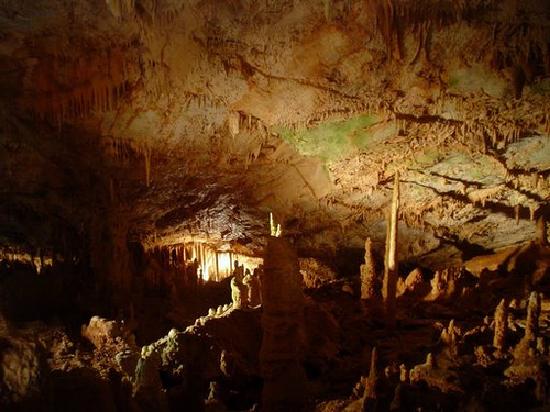

Location: 4 km (2.5 mi) West of Paiania
Tel. 210 664 2108
+30 10 664 2910
Open: 9am- 4:30pm daily
Entrance Fee: 2 Euro
Koutouki Cave (Greek: Σπήλαιο Κουτουκιού), also known as Paiania Cave or Spilia Koutouki, is a remarkable limestone cave located on the eastern slopes of Mount Hymettus in Paiania (Peania), East Attica, Greece, approximately 25 kilometers southeast of Athens and near the Athens International Airport. Discovered in 1926, it is the largest and most accessible cave in the Attica region, spanning a total explored length of about 350 meters with a main chamber measuring 60 meters by 60 meters and a maximum depth of 38.5 meters. The cave is renowned for its rich and diverse speleothems (cave formations), including multicolored stalactites, stalagmites, columns, draperies, and flowstones, many tinged with rust-red hues from iron oxide deposits. As a protected natural monument, it maintains a constant temperature of around 17°C (63°F) and high humidity, creating an otherworldly subterranean environment. Managed by the Greek Ministry of Culture, it serves as a popular day-trip destination from Athens, attracting visitors for its geological beauty and guided tours featuring a light and sound show. In 2025, the cave continues to be a highlight for eco-tourism in Attica, emphasizing sustainable visitation.
The cave's discovery in 1926 was accidental: a local shepherd noticed his goat had fallen through a small opening in the hillside, leading him to explore the fissure and uncover the vast underground chamber. Initial explorations revealed its impressive size and formations, prompting scientific interest. By the 1950s, the cave was developed for tourism under the auspices of the Greek Archaeological Service. An artificial entrance tunnel, 17 meters long and sloping downward, was constructed to provide safe access, replacing the original narrow vertical shaft. The site opened to the public in the 1960s, with pathways, stairs, and lighting installed to facilitate guided tours. Over the decades, it has undergone restorations to preserve its natural features, including measures to control humidity and prevent vandalism. Archaeological surveys have found limited evidence of ancient human use, such as Neolithic tools and pottery fragments, suggesting occasional shelter by prehistoric inhabitants, though no major settlements were established due to the cave's inaccessibility. In modern times, Koutouki has been featured in travel guides and documentaries, boosting its popularity. As of 2025, it remains under protection, with ongoing monitoring for seismic activity given Greece's earthquake-prone geology.
Koutouki Cave is a classic karst formation, created over hundreds of thousands of years through the dissolution of limestone by acidic rainwater seeping through cracks in Mount Hymettus' bedrock. The cave's development dates back to the Pleistocene era, when chemical erosion enlarged natural fissures into chambers and passages. It features a single large hall with sloping floors and a variety of speleothems formed by mineral-rich water deposits. Notable formations include elongated stalactites hanging from the ceiling like chandeliers, robust stalagmites rising from the floor, and fused columns that create dramatic pillars. Unique to Koutouki are the "curtains" or draperies—thin, wavy sheets of calcite—and helictites that defy gravity by growing sideways due to capillary action. The rust-red coloration comes from iron impurities in the limestone, giving the cave a warm, earthy palette that enhances its visual appeal under artificial lighting. The main chamber's vast size (60x60 meters) allows for a winding 350-meter tourist path that descends gradually, passing through narrower corridors and alcoves. No active streams exist today, but dripstone activity continues, slowly adding to the formations. The cave's stable microclimate—17°C year-round with 90-100% humidity—supports delicate crystal growth but also poses challenges for preservation, as human breath can alter CO2 levels and promote algae.
While not as rich in fossils as some Greek caves, Koutouki has yielded paleontological finds, including bones of Ice Age animals like deer and small mammals embedded in the sediments, dating back tens of thousands of years. These remains provide insights into the region's prehistoric fauna and climate. Ecologically, the cave hosts a fragile ecosystem with troglobitic (cave-adapted) species, such as blind insects, spiders, and bats (including the lesser horseshoe bat). The high humidity supports fungal growth and microbial communities that contribute to the cave's ongoing formation processes. Human impact has been minimized through controlled access, but light pollution from tours can affect bat populations. No major archaeological sites exist, but scattered Neolithic artifacts suggest brief use by early humans for shelter or rituals. The cave is part of broader conservation efforts in Mount Hymettus, a protected area under Natura 2000 for its biodiversity, including endemic plants and birds above ground.
Koutouki Cave is easily accessible from Athens, about a 30-45 minute drive via the Attiki Odos highway or public bus to Paiania, followed by a short taxi ride or hike up the hillside. As of 2025, it is open daily from 9:00 AM to 4:30 PM, though hours may vary seasonally or due to weather; confirm via the official Greek tourism website or by calling ahead. Admission is around €5 for adults, with discounts for children, students, and seniors; guided tours (in Greek and English) last 20-30 minutes and include a narrated light and sound show that illuminates the formations dramatically. The tour involves descending via the artificial tunnel and following a concrete path with railings and steps (about 200 steps total), making it moderately accessible but not wheelchair-friendly due to uneven terrain. Comfortable shoes are recommended, and photography is allowed without flash to protect the environment. Visitors often describe the experience as breathtaking, with the illuminated crystals creating a "fairy-tale" atmosphere. Nearby attractions include the Vorres Museum in Paiania and hiking trails on Mount Hymettus. Organized tours from Athens (around €50-80 including transport) are available for convenience. The site can get crowded in summer, so early visits are advised; winter offers a quieter experience with cooler temperatures outside.